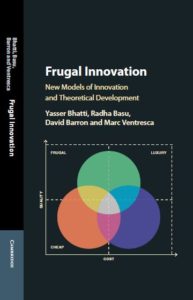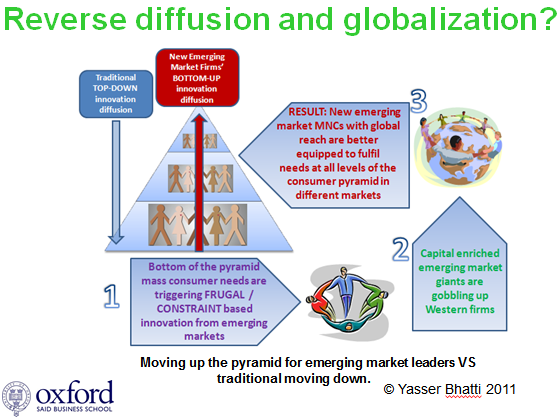New Book — Frugal Innovation: Models, Means, Methods. Cambridge University Press

Bhatti, Y., Basu, R., Barron, D., & Ventresca, M. 2018. Frugal Innovation: Models, Means, Methods. Cambridge University Press.
Cambridge website / Amazon website
In light of growing discourse on ‘frugal innovation’, this book offers novel approaches to innovation based on extensive empirical research. The study complements a decade of scholarly attention on frugal innovation by taking a research-based approach to innovation in resource-scarce and complex institutional contexts. The findings suggest that concepts such as frugal, reverse, jugaad, social, grassroots and inclusive innovation in fact represent heterogeneous assemblies of innovation for social, environmental and economic value. The conceptual framework invites attention to more plural sources and elements in the study of models of innovation to inspire further research in the fields of strategy, innovation, entrepreneurship, economic sociology and development studies. The design framework offers models, metrics and competencies for practitioners and policymakers to identify, evaluate and design frugal innovations. The comprehensive view of frugal innovation demonstrates how firms can implement globally competitive strategies by pursuing innovation for humanity to improve lives for everyone, everywhere.
Foreword by Anita McGahan, Rotman Chair in Management and Professor of Strategic Management at Rotman School of Management, University of Toronto.
Order from Cambridge University Press or Amazon
Part I. Models of Frugal Innovation
Introduction
1. Outline of the Context, Literature and Methodology;
2. Conceptualising Innovation – Model 1
3. Conceptualising Innovation under Constraints – Model 2
Part II. Towards a Theory of Frugal Innovation
4. Integrative Results and Theory Development
5. Test of Models Using Secondary Cases
6. Emerging Concepts in Innovation
7. Implications for Research, Practice and Policy
Conclusion
Part III. Tools for Practice and Research
A. Toolkit to Identify and Categorise Frugal Innovations
B. Core Competencies from the Frugal Innovation Lab
C. Detailed Research Methodology and Design
References
Bilbiography of Frugal Innovation
Reviews
“Policymakers around the world and especially in emerging markets can leverage frugal innovations to better promote human welfare. The models and tools in this book should support leaders in their efforts to foster equitable growth and sustainable development.”
Shaukat Aziz
Chairman of the Oxford Emerging Markets Symposium Steering Committee and former Prime Minister of Pakistan
“This book should give tremendous impetus for serious and rigorous academic research on innovation under severe constraints.”
Vijay Govindarajan
Coxe Distinguished Professor at Tuck, Dartmouth and author of the NYT Best Seller, Reverse Innovation
“This book complements previous books in helping to establish frugal innovation as a field that merits serious attention in the diverse worlds of academia, practice and policy. It extends prior work by developing models, frameworks and tools to help scholars, innovators and managers to deliver meaningful and much needed innovation for all of humanity.”
Jaideep Prabhu
Professor of Marketing at Judge Business School, Cambridge and author of best sellers Jugaad Innovation and Frugal Innovation
“To solve the wicked problems confronting humanity and the planet, we need frugal innovators—wise problem solvers who operate with a business mind, social heart, and ecological soul. Building on earlier works on frugal innovation, this scholarly book offers a rigorous theoretical framework to understand, teach, and practice the art and science of designing and delivering frugal solutions that integrate six key elements: affordability, accessibility, simplicity, sustainability, quality, and purpose.”
Navi Radjou
Fellow at Judge Business School, University of Cambridge and coauthor of Jugaad Innovation and Frugal Innovation
“Frugal innovation is a topic of considerable interest to companies, policy makers and researchers. It offers both innovation to connect the poorest and most disadvantaged citizens to the benefits of new products and services and opportunities for firms to identify new and potentially lucrative markets. This important book offers important new conceptual and practical insights into frugal innovation and should be seen as essential reading for anyone engaging with this topic.”
Alex Nicholls
Professor of Social Entrepreneurship, Said Business School and Fellow in Management, Harris Manchester College, University of Oxford.
“Targeted to scholars and providing a solid foundation for future research, Frugal Innovation also offers keen insights on how social entrepreneurs conceive of innovation in multiple dimensions. Practitioners will find experience-based frameworks that help them synthesize and communicate the integrative nature of innovations that benefit the underserved. Like social entrepreneurship, frugal innovation is a term with many meanings. Integrative, synthetic, and clear, the authors examine multiple dimensions of innovation and distill frugal innovation as a hybrid approach tuned to environments with extreme resource constraints and resource voids. Both researchers and practitioners will benefit from learning how social entrepreneurs themselves perceive innovation.”
Thane Kreiner
Howard and Alida Charney University Professor and Executive Director, Miller Center for Social Entrepreneurship, SCU
“Frugal Innovation: New Models of Innovation and Theoretical Development will be a must have for academics, entrepreneurs, corporates and investors. It will advance how to get to inclusive solutions not merely based on cost-effectiveness and financial returns but combining them with purpose & impact. This book shows that Frugal Innovation is not just another innovation term but the empirical based models and theories that the authors have proposed will help enable creating & scaling solutions under resource constraints both by social entrepreneurs & traditional businesses.”
Venkata Gandikota
President and co-founder, The Nordic Frugal Innovation Society
“New models of innovation are desperately needed in global health systems which are being squeezed by increasing demand, declining budgets and rising complexity of disease. This book shows how frugal innovations can play a vital role in containing soaring healthcare costs while upholding quality standards, something which simply cannot be compromised in healthcare.”
Ara Darzi
Professor of Surgery at Imperial College London, member of the United Kingdom’s House of Lords and former Parliamentary Under-Secretary of State at the Department of Health.
“This book is needed! The marrying of social value and business value has gained steam in many circles with a focus on value – both human and economic. Frugal Innovation widens the path for intrepid innovators by grounding insightful conceptual frameworks upon an extensive base of empirical evidence.”
Kristian Olson
Director of the Consortium for Affordable Medical Technologies and Associate Professor, Harvard University Medical School
Frugal-Reverse-Cost-BOP Innovation
CEO of GE Jeff Immelt calls the frugal innovation phenomenon reverse innovation. “If GE doesn’t master reverse (frugal) innovation, the emerging giants could destroy the company” (Immelt, Govindarajan, and Timble, 2009). Although there are several dimensions to frugal innovation, the overarching theme is simplification in process and outcome. There can be many connotations for “reverse” which are similar to frugal innovation in both process and outcome.
One, frugal or reverse innovation integrates specific needs of the bottom of the pyramid markets as a starting point and works backward to develop appropriate solutions which may be significantly different from existing solutions designed to address needs of upmarket segments (Silicon India, 2010). The context in which this innovation is seen occuring in lies in developing markets. Fu, Soete & Sonne (2010) claim that the innovation process itself is now likely to be reversed, starting with the design phase which will, to a large extent, be concerned with finding functional solutions for some of the particular BoP users’ framework conditions… (such as) a clear adaptation to the often poor local infrastructure facilities with respect to energy delivery systems, water access, transport infrastructure, digital access.
Two, there is a reverse process of diffusion among consumers. Innovation is often perceived in the developed world as technological revolutionary products tried and tested by innovators and early adopters (Rogers, 1962). Trendy and expensive products are accepted by the top of the pyramid first which then get trickled down to the masses or early and late majority consumers. Professional groups in the highest income bracket in society that constitute the “tip” of the income pyramid act as the early adopters and the first try-out group, contributing to the innovation monopoly rents of the innovating firm. But this “professional-use driven” innovation circle has been the main source for extracting innovation rents out of consumer goods that was considered “too long” (Fu et al, 2010). Hence, in frugal innovation we see a challenge to this notion of diffusion from the top to the bottom. Frugal innovation “reverses” the process of diffusion by targetting the early and late majority consumers and relies on profiting not from monopoly rents, but rather economies of scale rents. Eventually, all segments of the market benefit from the innovation. A prime example of this is mobile phone banking by Telenor in Pakistan and MPesa in Kenya wherein success has in these business models have been marked through adoption by rural BOP consumers before becoming popular in all segments rural and urban.
Three, we might see a trend in practices of innovation being adopted from the East to the West wherein Western practices had dominated thus far. Innovation is no longer formulated just in the West and exported to the developing world. Instead, many new innovations that are considered “frugal” will emanate from the emerging world and into the West (The Economist, 2010). Again, mobile phone banking and inexpensive and portable medical devices are emanating from emerging / developing markets but could find their way to mature markets.
I believe frugal holistically describes the phenomenon more aptly. Reverse innovation, to me, is based on a primary characteristic of the phenomenon which is bottom-up and East-to-West. Others have called this phenomenon “Cost” innovation (Li and Hang, 2010) and “BOP” innovation (Prahalad, 2005) which limits the definition to simply reduction in cost of outcome for a specific target market. Instead, frugal innovation embodies the frame of mind, philosophy, process, and purpose behind this phenomenon spanning from exploration to exploitation phases. More on this later!

